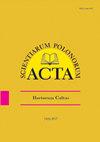香茅挥发油的化学性质及体外生物活性评价
IF 0.7
4区 农林科学
Q4 HORTICULTURE
引用次数: 1
摘要
在Clevenger型装置中通过加氢蒸馏从在塞尔维亚培养的Nepeta cataria L.var.citriodora(Becker)的地上部分获得的精油(EO)进行气相色谱-质谱(GC-MS)以测定成分。此外,还对香茅挥发油进行了体外抗菌、抗氧化、抗高血糖和抗炎活性测定。采用肉汤微量稀释法对来自美国典型培养物保藏中心(ATCC)的16株细菌进行了抗菌活性测试。采用四种常用的体外抗氧化活性测定方法:2,2-二苯基-1-苦基肼法(DPPH)、还原力法(RP)、2,2-嗪基双-3-乙基苯并噻唑啉-6-磺酸法(ABTS)和β-胡萝卜素漂白法(BCB)。用α-葡萄糖苷酶抑制电位(AHgA)检测抗高血糖活性,用蛋白变性生物测定法测定抗炎活性(AIA)。采用气相色谱-质谱联用技术,共分离和检测到36个化合物。EO主要由含氧单萜(93.1%)组成,主要化合物为两种单萜醇,橙花醇(38.5%)和香叶醇(24.9%),其次是两种脂族醛,香叶醛(14.6%)和普通醛(11.0%),抗高血糖和抗炎活性。从生长在塞尔维亚的C.cataria var.citriodora中获得的EO显示出有价值的生物活性,表明其有潜力用作日常饮食中的补充剂和食品工业中的天然防腐剂。本文章由计算机程序翻译,如有差异,请以英文原文为准。
Chemical profile of Nepeta cataria L. var. citriodora (Becker) essential oil and in vitro evaluation of biological activities
Essential oil (EO) obtained by hydrodistillation in a Clevenger-type apparatus from aerial parts of Nepeta cataria L. var. citriodora (Becker), cultivated in Serbia was subjected to gas chromatography-mass spectroscopy (GC-MS) to determine the composition. Furthermore, N. cataria var. citriodora essential oil wastested to determine its antimicrobial, antioxidant, antihyperglycemic and anti-inflammatory activities in vitro.The antimicrobial activity was tested by broth microdilution method against 16 bacterial strains from American Type Culture Collection (ATCC). Four common tests for measuring in vitro antioxidant activity were used: 2, 2-diphenyl-1-picrylhydrazyl assay (DPPH), reducing power (RP), 2,2-azino-bis-3-ethylbenzothiazoline-6-sulfonic acid (ABTS) and β-carotene bleaching assay (BCB). Antihyperglycemic activity was examined by using α-glucosidase inhibitory potential (AHgA), while anti-inflammatory activity (AIA) was determined by protein denaturation bioassay, using egg albumin. In total, 36 compounds were isolated and detected by GC-MS technique in N. cataria var. citriodora EO. The EO is mainly comprised of oxygenated monoterpenes (93.1%), and the main compounds were two monoterpenoid alcohols, nerol (38.5%) and geraniol (24.9%), followed by two aliphatic aldehyde, geranial (14.6%) and neral (11.0%). Antimicrobial activity of this EO shows growth inhibition of all tested bacteria strains, and exhibited good antioxidant, antihyperglycemic and anti-inflammatory activities. The EO obtained from N. cataria var. citriodora grown in Serbia shows valuable biological activity, indicating its potential for use as a supplement in everyday diet and as a natural preservative in food industry.
求助全文
通过发布文献求助,成功后即可免费获取论文全文。
去求助
来源期刊
CiteScore
1.30
自引率
14.30%
发文量
61
审稿时长
4-8 weeks
期刊介绍:
In Acta Scientiarum Polonorum Hortorum Cultus we publish original research papers and review articles containing new and significant information on broad aspects of horticulture and related disciplines. The papers are published in English only, in six issues yearly.

 求助内容:
求助内容: 应助结果提醒方式:
应助结果提醒方式:


